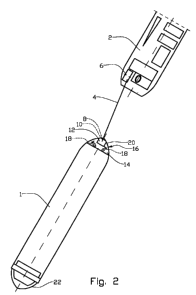Une partie des informations de ce site Web a été fournie par des sources externes. Le gouvernement du Canada n'assume aucune responsabilité concernant la précision, l'actualité ou la fiabilité des informations fournies par les sources externes. Les utilisateurs qui désirent employer cette information devraient consulter directement la source des informations. Le contenu fourni par les sources externes n'est pas assujetti aux exigences sur les langues officielles, la protection des renseignements personnels et l'accessibilité.
L'apparition de différences dans le texte et l'image des Revendications et de l'Abrégé dépend du moment auquel le document est publié. Les textes des Revendications et de l'Abrégé sont affichés :
| (12) Brevet: | (11) CA 2680755 |
|---|---|
| (54) Titre français: | PROCEDE ET DISPOSITIF DE COUPLAGE D'UN PETROLIER EN MER |
| (54) Titre anglais: | METHOD AND DEVICE FOR CONNECTING A TANKER AT SEA |
| Statut: | Réputé périmé |
| (51) Classification internationale des brevets (CIB): |
|
|---|---|
| (72) Inventeurs : |
|
| (73) Titulaires : |
|
| (71) Demandeurs : |
|
| (74) Agent: | RIDOUT & MAYBEE LLP |
| (74) Co-agent: | |
| (45) Délivré: | 2014-09-09 |
| (86) Date de dépôt PCT: | 2008-03-11 |
| (87) Mise à la disponibilité du public: | 2008-10-23 |
| Requête d'examen: | 2013-02-06 |
| Licence disponible: | S.O. |
| (25) Langue des documents déposés: | Anglais |
| Traité de coopération en matière de brevets (PCT): | Oui |
|---|---|
| (86) Numéro de la demande PCT: | PCT/NO2008/000088 |
| (87) Numéro de publication internationale PCT: | WO2008/127117 |
| (85) Entrée nationale: | 2009-09-14 |
| (30) Données de priorité de la demande: | ||||||
|---|---|---|---|---|---|---|
|
L'invention concerne un procédé et un dispositif de couplage d'un pétrolier (1) à une installation de chargement (2) en mer dans lequel, après s'être positionné au niveau de l'installation de chargement (2), le pétrolier (1) est couplé à une conduite de chargement (4) pour transférer un fluide de l'installation de chargement (2) au pétrolier (1), et dans lequel la poupe (20) du pétrolier (1) est tournée vers l'installation de chargement (2), le pétrolier (1) étant pourvu, au niveau de sa poupe (20), d'une machinerie de propulsion (16) pouvant être dirigée dans un plan horizontal, et dans lequel la conduite de chargement (4) est ensuite couplée à un distributeur de chargement (10) positionnée au niveau de la poupe (20) du pétrolier (1).
A method and device for connecting a tanker (1) at a loading facility (2) at sea, in which, after having positioned itself at the loading facility (2), the tanker (1) is connected to a loading hose (4) for fluid to be transferred from the loading facility (2) to the tanker (1), and in which the stern (20) of the tanker (1) is turned towards the loading facility (2), the tanker (1) being provided, at its stern (20), with propulsion machinery (16) steerable in the horizontal plane, and in which the loading hose (4) is then connected to a cargo manifold (10) positioned at the stern (20) of the tanker (1).
Note : Les revendications sont présentées dans la langue officielle dans laquelle elles ont été soumises.
Note : Les descriptions sont présentées dans la langue officielle dans laquelle elles ont été soumises.

Pour une meilleure compréhension de l'état de la demande ou brevet qui figure sur cette page, la rubrique Mise en garde , et les descriptions de Brevet , États administratifs , Taxes périodiques et Historique des paiements devraient être consultées.
| Titre | Date |
|---|---|
| Date de délivrance prévu | 2014-09-09 |
| (86) Date de dépôt PCT | 2008-03-11 |
| (87) Date de publication PCT | 2008-10-23 |
| (85) Entrée nationale | 2009-09-14 |
| Requête d'examen | 2013-02-06 |
| (45) Délivré | 2014-09-09 |
| Réputé périmé | 2017-03-13 |
Il n'y a pas d'historique d'abandonnement
| Type de taxes | Anniversaire | Échéance | Montant payé | Date payée |
|---|---|---|---|---|
| Le dépôt d'une demande de brevet | 400,00 $ | 2009-09-14 | ||
| Taxe de maintien en état - Demande - nouvelle loi | 2 | 2010-03-11 | 100,00 $ | 2009-09-14 |
| Taxe de maintien en état - Demande - nouvelle loi | 3 | 2011-03-11 | 100,00 $ | 2011-01-27 |
| Taxe de maintien en état - Demande - nouvelle loi | 4 | 2012-03-12 | 100,00 $ | 2012-02-14 |
| Taxe de maintien en état - Demande - nouvelle loi | 5 | 2013-03-11 | 200,00 $ | 2013-01-15 |
| Requête d'examen | 800,00 $ | 2013-02-06 | ||
| Taxe de maintien en état - Demande - nouvelle loi | 6 | 2014-03-11 | 200,00 $ | 2014-01-22 |
| Taxe finale | 300,00 $ | 2014-06-16 | ||
| Taxe de maintien en état - brevet - nouvelle loi | 7 | 2015-03-11 | 200,00 $ | 2015-02-16 |
Les titulaires actuels et antérieures au dossier sont affichés en ordre alphabétique.
| Titulaires actuels au dossier |
|---|
| TEEKAY NORWAY AS |
| Titulaires antérieures au dossier |
|---|
| HANSEN, HANS RICHARD |
| NORDTVEIT, REINERT |